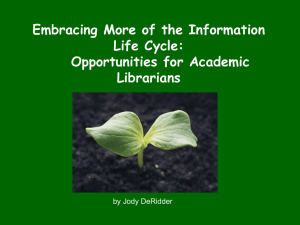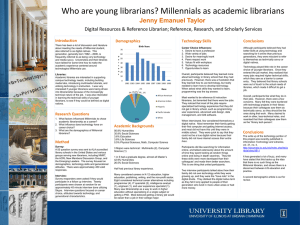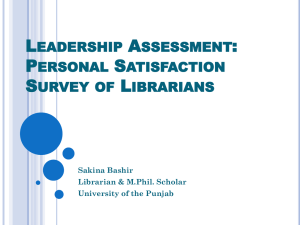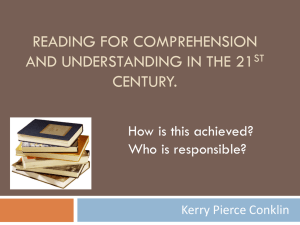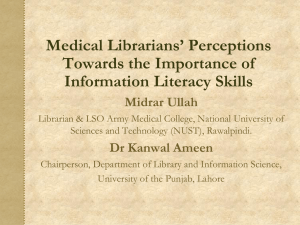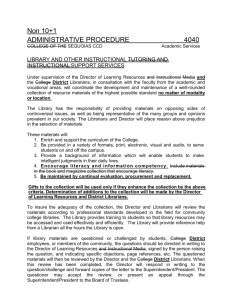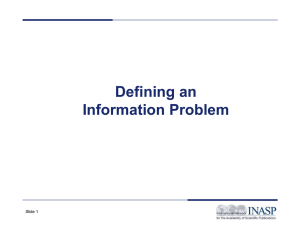Talking Points
advertisement
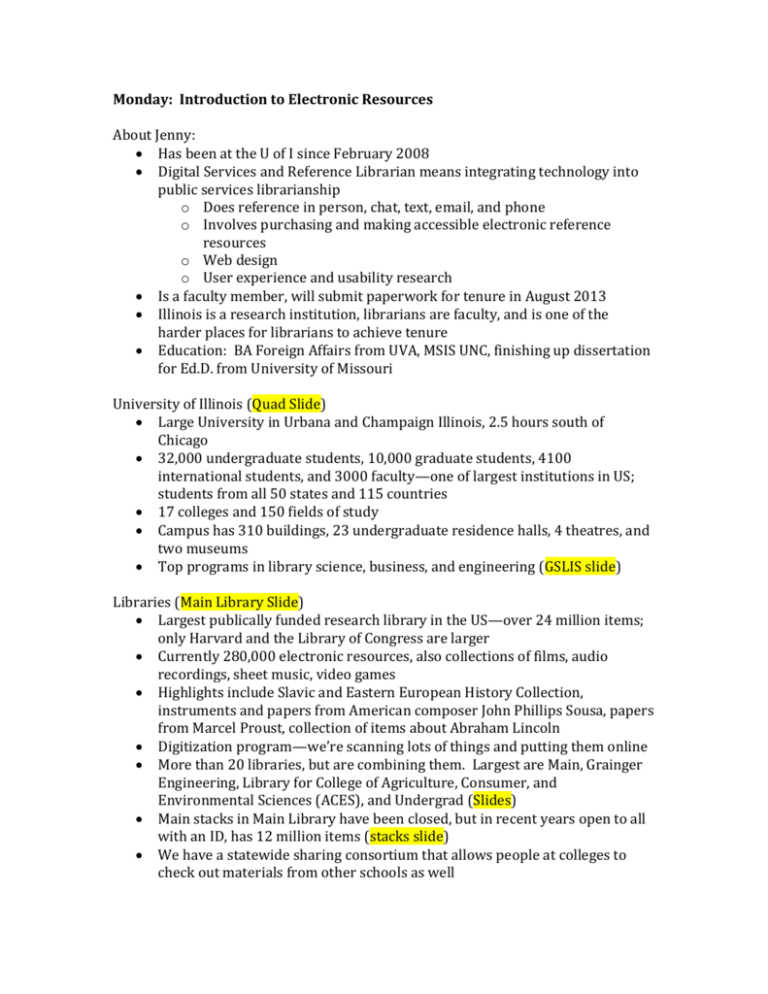
Monday: Introduction to Electronic Resources About Jenny: Has been at the U of I since February 2008 Digital Services and Reference Librarian means integrating technology into public services librarianship o Does reference in person, chat, text, email, and phone o Involves purchasing and making accessible electronic reference resources o Web design o User experience and usability research Is a faculty member, will submit paperwork for tenure in August 2013 Illinois is a research institution, librarians are faculty, and is one of the harder places for librarians to achieve tenure Education: BA Foreign Affairs from UVA, MSIS UNC, finishing up dissertation for Ed.D. from University of Missouri University of Illinois (Quad Slide) Large University in Urbana and Champaign Illinois, 2.5 hours south of Chicago 32,000 undergraduate students, 10,000 graduate students, 4100 international students, and 3000 faculty—one of largest institutions in US; students from all 50 states and 115 countries 17 colleges and 150 fields of study Campus has 310 buildings, 23 undergraduate residence halls, 4 theatres, and two museums Top programs in library science, business, and engineering (GSLIS slide) Libraries (Main Library Slide) Largest publically funded research library in the US—over 24 million items; only Harvard and the Library of Congress are larger Currently 280,000 electronic resources, also collections of films, audio recordings, sheet music, video games Highlights include Slavic and Eastern European History Collection, instruments and papers from American composer John Phillips Sousa, papers from Marcel Proust, collection of items about Abraham Lincoln Digitization program—we’re scanning lots of things and putting them online More than 20 libraries, but are combining them. Largest are Main, Grainger Engineering, Library for College of Agriculture, Consumer, and Environmental Sciences (ACES), and Undergrad (Slides) Main stacks in Main Library have been closed, but in recent years open to all with an ID, has 12 million items (stacks slide) We have a statewide sharing consortium that allows people at colleges to check out materials from other schools as well Introduction to E-Resources I will talk all week about this I collect resources for central reference and mostly in humanities and social sciences o Biographical information o Encyclopedias o Foreign language indexes and dictionaries o International Bibliographies o Statistics o Government Information Years ago, was mostly print, now 50/50 (Ref Room Slide) Buy online indexes/databases, ebooks, datasets Much less print, so only on shelves around room and not in center of room Some reference materials moved to main stacks, others to Oak St. storage location (Oak St. Slide) Ebooks are becoming very popular because growth in tablets for reading as well as students are charged for printing and using paper Monday – Electronic Resources Collection Development Define electronic resources Databases: indexes and full text Journals Electronic Books Others: multimedia, data, etc Replacing/supplementing Print Moving more things to offsite storage if we have them reliably online Choosing Cost; licensing v ownership Replace/supplement print collection Free up space How many users can use at one time Ease of use Overlap with other print and electronic resources Growth of electronic books Some librarians buy many, others not as much Depends on cost, access, researcher preference, type of book DRM issues How people access Librarians create webpages, guides Catalog Open URL Search interfaces (Easy Search, Primo) Tuesday: What is an E-Resource and How is it different from Print Continue previous discussion I prefer ebooks to save space and because Reference involves looking up facts, which is easy to do online I keep track of new resources through conferences, vendor announcements and mailings, Choice Reviews, and American Reference Books Annual (ARBA) Subject librarians purchase books through approval plans Some recommendations by faculty, but librarians tend to not order everything that is requested; use their judgement Tuesday: How is access important to e-resources OpenURL: What it is; another name “link resolver” SFX, Serials Solutions, TDNet big companies Connects resources together; if one does not have full text, you click a link to see if text is in another resources Has made electronic resources much easier to use since you do not have to look things up in multiple places; works 90% of time OpenURL technology also gives us an A-Z and subject list of all electronic journals that we own At Illinois, we struggle with how best to display electronic resources o All are in SFX, and subject list o Librarians create webpages that teach electronic resources and provide lists of them in their subject areas All electronic resources get record in online catalog Ebooks are in catalog and we hope to have them in our OpenURL list so that people can browse through them as they would books on a physical shelf Federated Searching/Web Scale Allows searching of multiple library resources at once Illinois has locally developed Easy Search, others include EBSCO’s Discovery Service, ExLibris’ Primo, Serials Solutions Summon, OCLC’s WorldCat Local Problem is that these prefer products under one vendors and vendors do not like to share data with others. Examples: Proxy Server: Needed because vendors make sure resources only available to on campus IP addresses Proxy is a server that allows users to use library resources off campus All resource URLs in library webpage have a prefix that forces them to go through Proxy. If on campus IP address, they go straight through, from another IP address, they have to log in Prevents people from Googling a resource from off campus to get to it, must go through library website Electronic Reserves: Popular service, needed because of copyright restrictions and can make copies for educational use Professors request things be put on reserve, mostly electronic, some things scanned, others like (some) video, people must come checkout Everything password protected We have local system, other places use library catalog or Docutek Friday: Western Trends in Digital Librarianship About Jenny: Has been at the U of I since February 2008 Digital Services and Reference Librarian means integrating technology into public services librarianship o Does reference in person, chat, text, email, and phone o Involves purchasing and making accessible electronic reference resources o Web design o User experience and usability research Is a faculty member, will submit paperwork for tenure in August 2013 Illinois is a research institution, librarians are faculty, and is one of the harder places for librarians to achieve tenure Education: BA Foreign Affairs from UVA, MSIS UNC, finishing up dissertation for Ed.D. from University of Missouri University of Illinois (Quad Slide) Large University in Urbana and Champaign Illinois, 2.5 hours south of Chicago 32,000 undergraduate students, 10,000 graduate students, 4100 international students, and 3000 faculty—one of largest institutions in US; students from all 50 states and 115 countries 17 colleges and 150 fields of study Campus has 310 buildings, 23 undergraduate residence halls, 4 theatres, and two museums Top programs in library science, business, and engineering (GSLIS slide) Libraries (Main Library Slide) Largest publically funded research library in the US—over 24 million items; only Harvard and the Library of Congress are larger Currently 280,000 electronic resources, also collections of films, audio recordings, sheet music, video games Highlights include Slavic and Eastern European History Collection, instruments and papers from American composer John Phillips Sousa, papers from Marcel Proust, collection of items about Abraham Lincoln Digitization program—we’re scanning lots of things and putting them online More than 20 libraries, but are combining them. Largest are Main, Grainger Engineering, Library for College of Agriculture, Consumer, and Environmental Sciences (ACES), and Undergrad (Slides) Main stacks in Main Library have been closed, but in recent years open to all with an ID, has 12 million items (stacks slide) We have a statewide sharing consortium that allows people at colleges to check out materials from other schools as well Trends: All librarians have strong tech skills and can understand the back end as well as deliver public services o Understand how library resources are organized o Understand the role of various servers o Understanding of web design, usability, and information architecture o More and more of what library does is not centered around a print collection o We must be experts in finding information online, whether on Internet or library resources o We also lead the fight for freedom of information and access to information (examples) Instruction is very important Many places require a second masters degree, and it seems like more librarians are getting doctorates o Good because then we have better understanding of research and research process Growing divide over librarians who do rigorous research and those who do not Also, more discussions about faculty status for librarians. Many argue for it because it means we’re equal to teaching faculty o But fewer faculty are tenure track o For some, having same research requirements as faculty cumbersome o Being faculty and having tenure provides more job security
